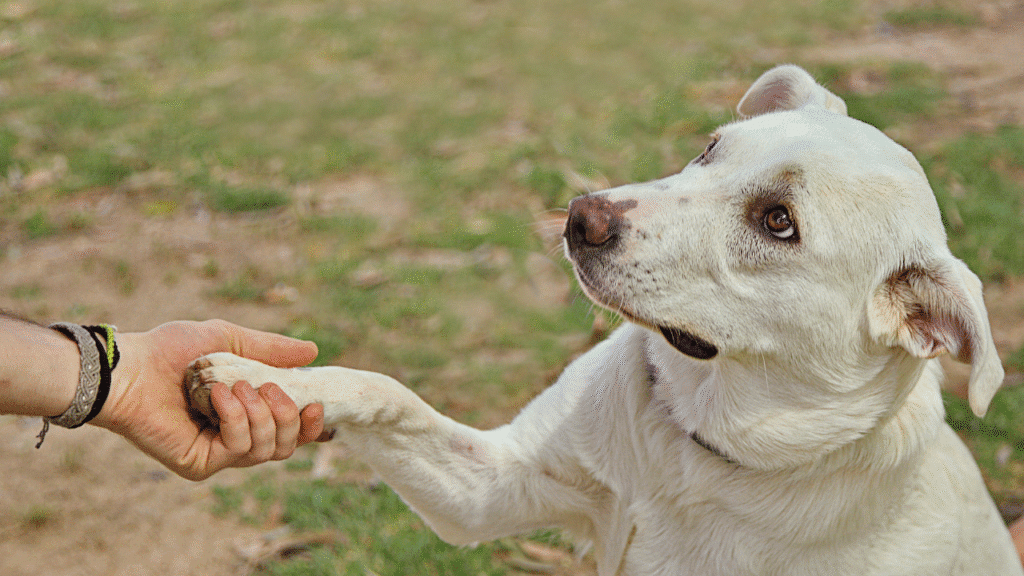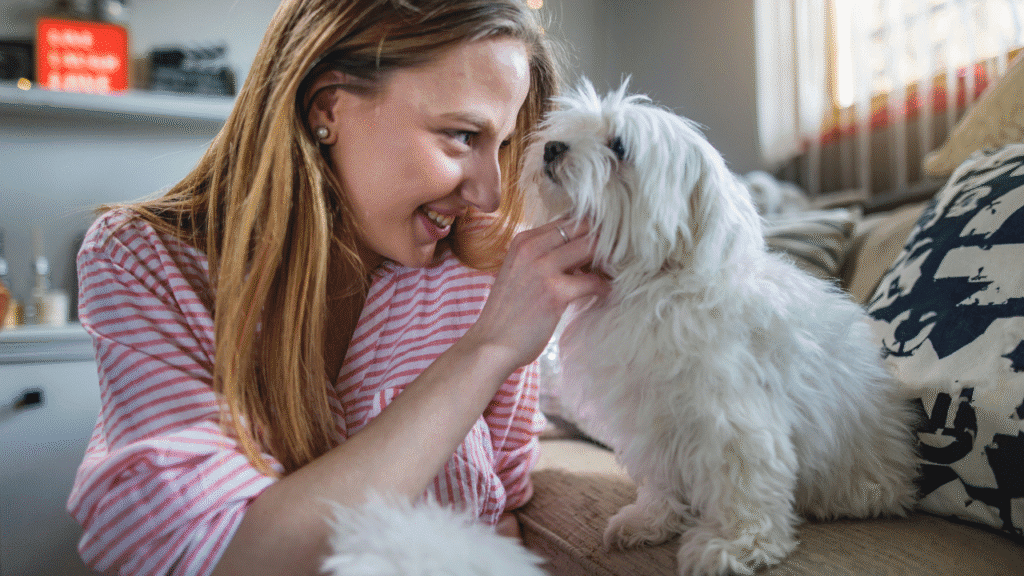Hey There! Some links on this page are affiliate links, which means that as an Amazon Associate, I may earn a small commission at no extra cost to you. I greatly appreciate your support! Learn more on my Affiliate Disclosure page.
Does your home sometimes feel like a nonstop canine concert? You’re not alone. Many pet parents struggle with vocal pups who express themselves a little too enthusiastically. While barking comes naturally to our four-legged companions, constant noise can test even the most patient households.
The secret lies in understanding why your pet communicates this way. Just like humans, animals use vocalizations for countless reasons—from excitement during playtime to anxiety when left alone. Some might be guarding their territory, while others crave your attention.
Rather than silencing your companion completely, our approach focuses on balanced communication. We’ll help you decode the meaning behind those woofs and create strategies that work with your pet’s instincts, not against them. Imagine transforming those noisy moments into opportunities for deeper connection!
Through positive reinforcement and simple routine adjustments, you can teach appropriate behavior while respecting your pal’s need to express themselves. This guide offers practical solutions that maintain household harmony without compromising your bond. Ready to turn down the volume on frustration and amplify understanding?
Understanding Dog Barking Behavior

Your furry friend’s voice carries meaning, but when does it cross the line? Vocalizations are natural for pets, serving as their primary means of expressing needs and emotions. Learning to interpret these signals helps you respond effectively while maintaining peace at home.
Recognizing Normal vs. Excessive Patterns
Healthy communication includes brief alerts when someone arrives or cheerful yips during fetch. These normal behaviors have clear triggers and stop once the situation resolves. For example, a few woofs at the mail carrier is typical—nonstop noise long after they’ve left? That’s a red flag.
| Situation | Normal Response | Excessive Pattern |
| Visitors at the door | 3–4 barks, then calm | Continuing for 10+ minutes |
| Playtime excitement | Short, happy vocalizations | Uncontrollable barking during calm moments |
| Home alone | Occasional whining | Persistent howling for hours |
Spotting the Root Causes
Notice when and why your pal gets vocal. Are they guarding their favorite toy? Stressed by loud noises? Boredom and loneliness often fuel repetitive noise. Watch for clues like raised hackles (alertness) or pacing (anxiety). Some breeds, like Beagles, naturally express themselves more—their “excessive” might just be their normal!
Identifying Common Triggers and Underlying Issues

Does your peaceful afternoon suddenly erupt with unexpected woofs and howls? Pinpointing what sparks these outbursts helps address the root of the behavior rather than just the noise. Let’s examine the underlying causes behind those vocal outbursts.
What Sets Off the Alarm?
Everyday sights and sounds often act like invisible triggers. Common culprits include:
- Doorbell rings that launch a protective chorus
- Passing delivery trucks triggering territorial responses
- Neighborhood pets visible through windows
Separation anxiety shows up differently—think panicked whine-howls when you grab your keys. This distress differs from attention-seeking yaps that stop once you engage. Watch for pacing or destructive chewing as clues.
Guarding instincts kick in when your pal perceives threats—a low growl at strangers near their bed or food bowl signals protective behavior. Frustration builds when barriers block desired actions, like meeting guests at the door.
Changes in routine—such as new work hours or relocating to a new home—can increase vocal stress signals. Keep a simple log noting:
- Time of day
- Triggers observed
- Duration of episodes
This detective work reveals patterns, helping you craft targeted solutions. Remember, what seems “excessive” might be your dog’s way of navigating overwhelming situations.
Effective Ways to stop excessive barking in dogs
Transforming vocal outbursts into calm interactions starts with smart dog training strategies. Positive reinforcement creates win-win scenarios where your pal discovers better ways to express themselves while earning rewards they love.
Reward-Based Behavior Shaping
Begin by teaching a “speak” command during playful moments. When your companion barks on cue, immediately offer a high-value treat. This controlled exercise helps them understand that barking happens only when invited. Once mastered, wait for natural pauses in vocalizations to introduce your quiet signal.
| Training Step | Action | Reward |
| Introduce “speak” | Use a trigger (door knock sound) | Cheese or chicken bits |
| Capture quiet | Mark silence with a clicker | Play tug-of-war |
| Add “quiet” cue | Whisper a command during calm | Long-duration petting |
Mastering the Silence Signal
Timing is crucial when reinforcing peaceful moments. Keep treats ready during relaxed periods—when your pal glances at you without vocalizing, instantly praise and reward. Gradually pair these moments with your chosen word, such as “enough,” spoken in a calm tone.
Practice daily in low-distraction areas before testing skills during real triggers. If they respond to your cue, celebrate with their favorite game! Over time, this method helps teach dog companions to switch gears from alert mode to composed behavior.
Creating a Calming Home Environment
Your living space plays a bigger role in your pet’s behavior than you might think. Simple tweaks to sights and sounds around the house often bring fast relief for vocal stress signals. Think of it as setting the stage for peaceful interactions while deeper training takes root.
Managing Noise and Distractions
Privacy window films work like magic for pups who react to outdoor movement. These translucent sheets let light in while blurring passersby—no more squirrel TV marathons! Apply them to street-facing windows where your companion spends hours on guard duty.
Mask disruptive outdoor sounds with rhythmic background noise. A white noise machine near entryways helps drown out the sounds of delivery trucks or chatty neighbors. Many owners swear by music specifically designed for pets, such as the “Through a Dog’s Ear” series, which features calming piano melodies.
Create a cozy retreat using these steps:
| Step | Description |
|---|---|
| Choose a Quiet Spot | Select a low-traffic corner away from doors, windows, and noisy areas. |
| Add Comfort and Familiarity | Place a chew-proof bed and blankets that carry your scent for reassurance. |
| Limit Visual Triggers | Use baby gates or barriers to block the view of outdoor distractions or visitors. |
Strategic furniture placement also makes a difference. Move that favorite couch away from the front window—without a clear view of the sidewalk, your pal’s urge to “report” every movement decreases naturally. These changes yield results within days, providing you with breathing room to practice quiet commands.
“Environmental adjustments fix 50% of barking issues before training even begins.”
Pair these modifications with consistent rewards for calm behavior. You’ll soon notice fewer alerts about mail carriers and more relaxed naps in that new quiet zone!
Implementing Consistent Training Routines
Ever wonder why some training efforts stick while others fail to take hold? The answer lies in predictable patterns that help pets understand what you want them to do. Like learning a new language, your pal needs regular practice sessions to build lasting habits.
Establishing Clear Expectations
Start by dedicating three 5-minute sessions daily—morning, afternoon, and evening. Use these moments to practice quiet commands, such as “settle,” when your dog is already calm. Keep rewards consistent: a clicker sound followed by chicken bits is more effective than random treats.
Mixed signals derail progress. If one family member shouts “hush!” while another offers toys during a noise-making session, your companion becomes confused. Hold a household meeting to agree on:
- Shared verbal cues (“enough” vs. “quiet”)
- Response protocols for vocal outbursts
- Designated trainers for each session
“Dogs thrive on routine—inconsistent reactions teach them to keep testing boundaries.” —Certified Canine Behavior Specialist
Adapting to Your Dog’s Learning Pace
High-energy breeds might master commands in a week, while shy pups need months. Notice when your pal gets restless—cut sessions short if they lose focus. Gradually introduce distractions once basic skills stick:
- Practice in silent rooms first
- Add soft music after three successful days
- Move to busier areas like near windows
Track progress weekly. Celebrate small wins—if they stop barking when you say “enough” once, that’s a start! With time and patience, those brief silences will stretch into lasting calm.
Handling Attention-Seeking Barking Appropriately

Ever caught your pup demanding your focus with dramatic vocal performances? Many clever companions learn that making noise gets results. The key lies in teaching them quieter ways to communicate while ensuring their core needs stay met.
What to Do and What to Avoid
First, determine if your pal truly needs something. Check for:
- Full water bowls
- Recent bathroom breaks
- Comfortable room temperature
If these basics are covered, those persistent dog barks likely seek interaction. Resist the urge to shout “quiet!” – even negative attention rewards the behavior. Instead, turn away and stay stone-still until silence returns.
Teach alternative requests using treats and toys as rewards. When your companion brings a ball instead of barking, celebrate instantly! Practice “sit for attention” during calm moments, rewarding polite behavior with ear scratches or playtime.
“Consistency turns temporary frustration into lasting results.” —Certified Animal Behavior Consultant
Prepare for the extinction burst – that initial surge of louder vocal protests when old tactics cease to work. Stay strong through this phase! Pair your calm response with increased proactive cuddles and games to show love isn’t earned through noise.
Preventing Barking Through Anticipation of Triggers

What if you could predict your companion’s vocal reactions before they begin? Successful prevention starts by recognizing the subtle signs your pal exhibits when sensing familiar challenges. Watch for stiffened posture, focused staring at windows, or sudden pacing—these are their way of saying, “I’m about to react!“
Mastering Threshold Management
Every animal has a breaking point where excitement tips into a full vocal response. Keep interactions positive below this threshold. If doorbell sounds trigger reactions, practice playing recordings at whisper volume while offering treats. Gradually increase the volume over several weeks as your companion remains calm.
For separation worries, create mini departures that build confidence. Leave for 30 seconds, return calmly, and reward quiet behavior. Extend time away slowly—this teaches that alone moments aren’t permanent. Pair your exits with special chew toys to form happy associations.
“Prevention isn’t about suppressing noise—it’s giving pets better tools to handle stress.” —Certified Separation Anxiety Trainer
Visitors often spark protective instincts. Teach your pal that guests mean rewards! Ask a friend to approach your door while you toss high-value treats. Repeat until your companion glances at you expectantly when someone arrives instead of barking.
Notice patterns in daily routines. Does the mail carrier’s 2 PM visit spark alerts? Five minutes before their arrival, engage your pal in a puzzle feeder or training game. Redirecting focus before triggers hit maintains calm and prevents rehearsed behaviors.
Watch for lip licking, yawning, or sudden sniffing—these signals indicate rising stress. Interrupt with a cheerful “Let’s play!” and lead them to a quiet zone. With consistent practice, you’ll be able to spot warning signs early and guide your friend toward peaceful responses.
Incorporating Enrichment and Regular Exercise
- 【Interactive Dog Puzzle Toys 】This is a fun interactive puzzle toy,which can encourage and train your dogs or cats to se…
- 【Squeaky Dog Toys】This dog puzzle toys is designed with a sounding device in the middle of the toy,which is to attract t…
- 【Mental Excecise&Boredom Buster】Our memory training puzzle toy can keep smart dogs busy and engaged in more thinking and…
A tired companion is a quiet companion, but true contentment comes from more than just physical exertion. Meeting your pal’s daily needs creates harmony where restless energy once fueled vocal protests. Balance movement, brain games, and nourishment help build lasting calm.
Fueling the Body and Mind
Not all dogs need the same kind of exercise—what works for a young Border Collie may overwhelm a senior Shih Tzu. Use the table below to match your dog’s activity needs based on their age, energy level, and personality.
| Dog Type / Personality | Recommended Exercise | Notes |
|---|---|---|
| High-Energy Breeds (e.g., Border Collies) | 90+ minutes of varied activity daily | Combine mental and physical challenges |
| Medium-Energy Adult Dogs | 20 minutes of fetch + 30-minute walk | Balances movement and bonding time |
| Anxious or Sensitive Dogs | Sniffaris (leisurely scent walks) | Calming and mentally enriching |
| Senior Dogs | Gentle, short walks | Prioritize low-impact movement |
| Dogs with Joint Concerns | Swimming or hydrotherapy sessions | Supports mobility without stressing joints |
Mental challenges drain energy twice as fast. Rotate three puzzle feeders weekly to prevent boredom. Try scattering kibble in grass for a natural scavenger hunt or freezing broth in rubber toys. One study showed a 68% reduction in nuisance vocalizations when pets received daily brain games.
“Enrichment isn’t optional—it’s essential for emotional well-being.”
Schedule meals around activity peaks. Offer breakfast after morning walks to curb food-focused fussing. Use slow feeders during quiet hours to extend chewing time and satisfaction. A content companion trading barks for naps? That’s the sweet spot every household deserves.
Conclusion

Building better communication with your four-legged friend takes time, but every quiet moment proves progress. The key lies in understanding what your pet needs to express—whether it’s boredom, stress, or playful excitement. Quick fixes, such as shouting or using anti-bark collars, often backfire, creating bigger behavioral challenges down the road.
Instead, focus on positive ways to help dog companions feel heard. Celebrate when they choose a chew toy over barking at squirrels or settle calmly during thunderstorms. Small victories add up! Remember, some breeds naturally share their opinions more loudly—your chatty pal might always announce visitors with gusto.
Stuck despite weeks of training? That’s your sign to call in certified pros. Veterinary behaviorists uncover hidden triggers, while trainers create customized plans. Most barking situations improve dramatically when you address the root problem rather than just the noise.
With patience and consistency, you’ll transform those loud moments into opportunities for connection. After all, every “woof” is a chance to strengthen your bond while building a happier home.
🐶 Thanks for reading! If this guide made your tail wag, be sure to follow Spiky Woofs on social for more tips on training, health, and everyday dog joy.
🐾 Until next time—happy tails and clean paws!
FAQ

How can I tell if my dog’s barking is a problem?
If vocalizations interrupt daily life or last longer than a few minutes, it might signal an issue. Watch for patterns, such as repetitive noise at specific triggers (e.g., doorbells) or when left alone.
What makes a pup bark at strangers or passing cars?
Territorial instincts or fear often drive this. Breeds like German Shepherds may guard instinctively, while others react to unfamiliar sights or sounds. Gradually exposing them to triggers can help reduce reactions.
Can treats really teach my pet to stay quiet?
Yes! Rewarding calm moments with high-value snacks, such as Zuke’s Mini Naturals, reinforces silence. Pair treats with a verbal cue like “quiet” to build a lasting association.
How do I handle whining for attention?
Ignore demands until they settle, then praise calm behavior. Avoid eye contact or touch during outbursts—consistency teaches that barking won’t earn playtime or cuddles.
Will background noise like TV help anxious dogs?
Soft music or white noise machines (such as LectroFan) can help mask outdoor sounds. Pair this with cozy spaces, such as a crate topped with a PetFusion blanket, to ease stress.
Can puzzle toys curb boredom-related vocalizing?
Absolutely! Toys like Kong Classic or Outward Hound puzzles keep minds busy. Rotate options weekly to maintain interest and keep them mentally engaged.
What if my companion barks when I leave home?
Gradual departures, using a Furbo camera, can help ease separation anxiety. Start with short absences, rewarding silence, and slowly increase time apart. Consult a vet if panic persists.
Are certain breeds harder to train out of barking?
Some, such as Beagles or Terriers, are more vocal due to their genetic makeup. However, patience and tailored methods—like scent games for hounds—can still foster quieter habits.
Hey There! Some links on this page are affiliate links, which means that as an Amazon Associate, I may earn a small commission at no extra cost to you. I greatly appreciate your support! Learn more on my Affiliate Disclosure page.
















